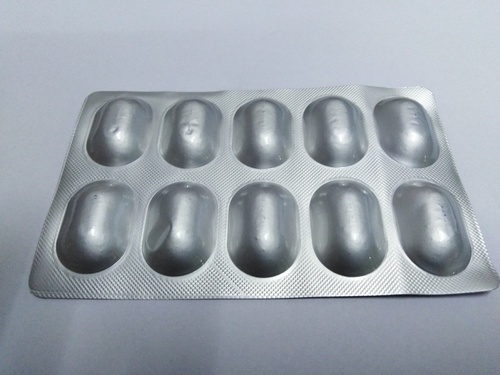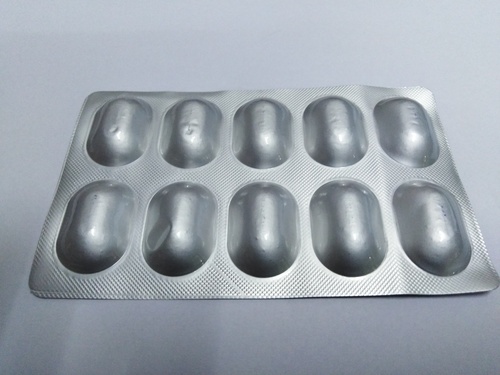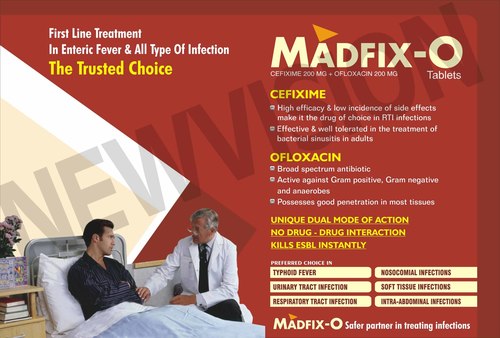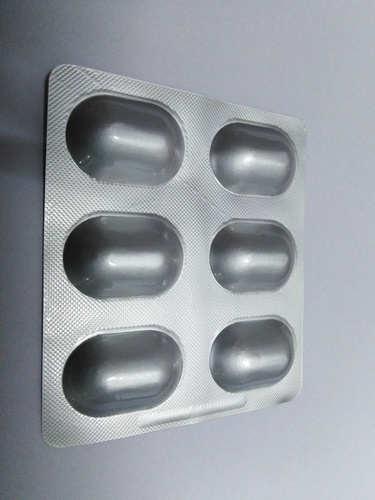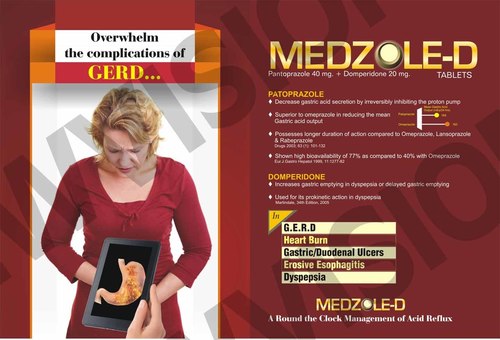
Aceclofenac 200 mg SR + Rabeprazole 20 mg Capsule
Product Details:
- Ingredients Rabeprazole 20mg + Aceclofenac 200mg Brands Prices, Side-effects ... sastimedicine.com/.../Rabeprazole-20mg-2B-Aceclofenac-200mg-Price-Dosage-Side-... Rabeprazole 20mg + Aceclofenac 200mg is Used for treatment of | Rabeprazole 20mg + Aceclofenac 200mg Generic Alternatives & Cost of Rabeprazole 20mg ...
- Physical Form Capsules
- Function Other
- Recommended For Suitable For All
- Dosage As directed by the Dietician
- Dosage Guidelines After Food
- Storage Instructions store in a cool & dry ,dark plase
- Click to View more
Aceclofenac 200 mg SR + Rabeprazole 20 mg Capsule Price And Quantity
- 10.00 - 100.00 INR/Box
- 500 Box
Aceclofenac 200 mg SR + Rabeprazole 20 mg Capsule Product Specifications
- Rabeprazole 20mg + Aceclofenac 200mg Brands Prices, Side-effects ... sastimedicine.com/.../Rabeprazole-20mg-2B-Aceclofenac-200mg-Price-Dosage-Side-... Rabeprazole 20mg + Aceclofenac 200mg is Used for treatment of | Rabeprazole 20mg + Aceclofenac 200mg Generic Alternatives & Cost of Rabeprazole 20mg ...
- Other
- Capsules
- Suitable For All
- After Food
- store in a cool & dry ,dark plase
- As directed by the Dietician
Aceclofenac 200 mg SR + Rabeprazole 20 mg Capsule Trade Information
- 1000 Box Per Day
- 30-45 Days
- Yes
- Within a certain price range free samples are available
- 10*10 &10*20
- All India
- Drug Licence, WHO GMP Certified,
Product Description
Rabeprazole is used to treat certain stomach and esophagus problems (such as acid reflux, ulcers). It works by decreasing the amount of acid your stomach makes. It relieves symptoms such as heartburn, difficulty swallowing, and persistent cough. This medication helps heal acid damage to the stomach and esophagus, helps prevent ulcers, and may help prevent cancer of the esophagus. Rabeprazole belongs to a class of drugs known as proton pump inhibitors (PPIs).
How to use Rabeprazole SODIUM
Read the Medication Guide and the Patient Information Leaflet if available from your pharmacist before you start taking rabeprazole and each time you get a refill. If you have any questions, ask your doctor or pharmacist.
If you are using the tablets, take your dose by mouth with or without food as directed by your doctor, usually 1 to 2 times daily. Swallow the tablet whole with water. Do not crush, chew, or split the tablet. Doing so can release all of the drug at once, increasing the risk of side effects.
If you are using the capsules, take the dose 30 minutes before a meal as directed by your doctor, usually once daily. Do not swallow the capsule whole. Open the capsule and sprinkle the contents onto a small amount of soft food (such as applesauce or yogurt) or liquid. The food or liquid that you use should be at or below room temperature. Swallow the entire mixture within 15 minutes of preparing it. Do not chew or crush the prepared mixture.
The dosage and length of treatment are based on your medical condition and response to treatment. In children, the dosage is also based on weight.
If needed, antacids may be taken along with this medication. If you are also taking sucralfate, take rabeprazole at least 30 minutes before sucralfate.
Use this medication regularly to get the most benefit from it. To help you remember, take it at the same time(s) each day. Continue to take this medication for the prescribed length of treatment even if you are feeling better.
Tell your doctor if your condition persists or worsens. The risk of side effects goes up over time. Ask your doctor how long you should take this medication.
Side Effects
Headache may occur. If this effect persists or worsens, tell your doctor or pharmacist promptly.
Remember that your doctor has prescribed this medication because he or she has judged that the benefit to you is greater than the risk of side effects. Many people using this medication do not have serious side effects.
Tell your doctor right away if you have any serious side effects, including: symptoms of a low magnesium blood level (such as unusually fast/slow/irregular heartbeat, persistent muscle spasms, seizures), signs of lupus (such as rash on nose and cheeks, new or worsening joint pain).
This medication may rarely cause a severe intestinal condition (Clostridium difficile-associated diarrhea) due to a type of bacteria. Do not use anti-diarrhea products or narcotic pain medications if you have any of the following symptoms because these products may make them worse. Tell your doctor right away if you develop: persistent diarrhea, abdominal or stomach pain/cramping, fever, blood/mucus in your stool.
Rarely, proton pump inhibitors (such as rabeprazole) have caused vitamin B-12 deficiency. The risk is increased if they are taken every day for a long time (3 years or longer). Tell your doctor right away if you develop symptoms of vitamin B-12 deficiency (such as unusual weakness, sore tongue, or numbness/tingling of the hands/feet).
A very serious allergic reaction to this drug is rare. However, get medical help right away if you notice any symptoms of a serious allergic reaction, including: rash, itching/swelling (especially of the face/tongue/throat), severe dizziness, trouble breathing, signs of kidney problems (such as change in the amount of urine).
This is not a complete list of possible side effects. If you notice other effects, contact your doctor or pharmacist.
Aceclofenac + Rabeprazole
About Aceclofenac + Rabeprazole
N/A
Mechanism of Action of Aceclofenac + Rabeprazole
N/A
Pharmacokinets of Aceclofenac + Rabeprazole
N/A
Onset of Action for Aceclofenac + Rabeprazole
N/A
Duration of Action for Aceclofenac + Rabeprazole
N/A
Half Life of Aceclofenac + Rabeprazole
N/A
Side Effects of Aceclofenac + Rabeprazole
1.Diarrhoea
2.Nausea
3.Dyspepsia,
4.Abdominal pain
5.Dizziness
6.Rashes
7.Potentially Fatal: nephrotoxicity; blood dyscrasias.
Contra-indications of Aceclofenac + Rabeprazole
1.Hypersensitivity to aspirin or NSAIDS
2.Moderate to severe renal impairment
3.History of peptic ulceration or GI bleed
4.Patients with infections.
Special Precautions while taking Aceclofenac + Rabeprazole
1.Cautiously administer to patients with GI disease
2.Ulcerative colitis
3.Crohn's disease
4.Haematological abnormalities
5.Hepatic porphyria
6.History of bronchial asthma
7.History of heart failure or hypertension
8.Mild renal, hepatic or cardiac impairment
9.May impair ability to drive or operate machinery
Pregnancy Related Information
Contra indicated in third trimester
Old Age Related Information
Use with caution
Breast Feeding Related Information
N/A
Children Related Information
N/A
Indications for Aceclofenac + Rabeprazole
1.Ankylosing spondylitis
2.Osteoarthritis
3.Rheumatoid arthritis
Interactions for Aceclofenac + Rabeprazole
N/A
Typical Dosage for Aceclofenac + Rabeprazole
N/A
Schedule of Aceclofenac + Rabeprazole
N/A
Storage Requirements for Aceclofenac + Rabeprazole
N/A
Effects of Missed Dosage of Aceclofenac + Rabeprazole
N/A
Effects of Overdose of Aceclofenac + Rabeprazole
N/A
Aceclofenac
About Aceclofenac
NSAID, Analgesic, Antiinflammatory, Anti arthritic.
Mechanism of Action of Aceclofenac
This drug has several mechanism of action.
1. It inhibits cyclooxygenase (COX) activity and to suppress the PGE2 production by inflammatory cells, by inhibiting IL-Beta & TNF in the inflammatory cells (Intracellular Action).
2. It blocks degeneration and stimulates synthesis of extra cellular matrix of cartilages by inhibiting the action of different cytokines.
3. Drug and its metabolites inhibit IL-6 production by human chondrocytes. This leads to inhibition of increase of inflammatory cells in synovial tissue, inhibition of IL-1 amplification, inhibition of increased MMP synthesis and thus ensuring proteoglycan production.
4. It inhibits IL-1 and TNF production by human chondrocytes, inflammatory cells and synovial cells and therefore blocks suppression of GAG and collagen synthesis and stimulates growth factors mediated synthesis of GAG and collagen.
5. 4`-hydroxyaceclofenac a metabolite of aceclofenac inhibits pro MMP1 and pro MMP3 produced by synovial cells (Rheumatoid Synovial Cells) in serum and in synovial fluid and thus inhibits progressive joint destruction by MMPs.
6. Aceclofenac inhibits Neutrophil Adhesion & Accumulation at the inflammatory site in the early phase and thus blocks the pro-inflammatory actions of Neutrophils.
7. Aceclofenac is also an NSAID with greater COX-2 specificity
Pharmacokinets of Aceclofenac
Absorption- It is rapidly and completely absorbed after oral administration
Distribution- Widely distributed in the body as protein-bound form. It is highly protein-bound (>99.7%). Aceclofenac penetrates into the synovial fluid, where the concentrations reach approximately 60% of those in plasma.
Metabolism- Metabolized into metabolites in the liver. Main metabolite is 4-hydroxyaceclofenac
Excretion- It is excreted through urine mainly as conjugated hydroxymetabolites
Onset of Action for Aceclofenac
N/A
Duration of Action for Aceclofenac
N/A
Half Life of Aceclofenac
The mean plasma elimination half-life is 4 - 4.3 hours
Side Effects of Aceclofenac
1. Dyspepsia
2. Abdominal pain
3. Dizziness
4. Vertigo
5. Pruritis
6. Rash
7. Dermatitis
8. Nausea
9. Diarrhoea
10. Flatulence
11. Gastritis
12. Constipation
13. Vomiting
14. Ulcerative stomatitis
15. Elevation of circulating levels of hepatic enzymes.
Contra-indications of Aceclofenac
1. Hypersensitivity to the drug
2. Bleeding from the stomach or intestines
3. Moderate to severely decreased kidney function
4. Hypersensitivity to other NSAIDs
5. Active peptic ulcer
Special Precautions while taking Aceclofenac
1. Hepatic porphyria
2. Bleeding tendencies
3. Blood disorders
4. Crohn`s disease
5. Decreased heart function
6. History of peptic ulcers
7. Inflammation of the bowel and back passage
8. Mildly decreased kidney function
9. Recent major surgery
10. Stomach disorders
11. Decreased liver function
12. Intestinal disorders
Pregnancy Related Information
Contraindicated.
Old Age Related Information
Use with caution.
Breast Feeding Related Information
Contraindicated.
Children Related Information
Use with caution
Indications for Aceclofenac
1. Ankylosing spondylitis
2. Osteoarthritis
3. Symptomatic treatment of pain and inflammation in Post-Traumatic pain
4. Cervical pain
5. Low back pain
6. Acute gout
Interactions for Aceclofenac
Lithium, digoxin and methotrexate: Aceclofenac may increase plasma concentrations of lithium, digoxin and methotrexate.
Anticoagulants: Activity of anticoagulants may be increased.
Diuretics : Aceclofenac inhibits the activity of diuretics. When concomitantly administrated with potassium sparing diuretics, serum potassium should be monitored.
Cyclosporin: Aceclofenac may enhance cyclosporin nephrotoxicity.
Quinolones : Aceclofenac may precipitate convulsions when coadministered with quinolone antibiotics.
Typical Dosage for Aceclofenac
Oral-
Adult (general dose)-
100mg twice daily
Schedule of Aceclofenac
H
Storage Requirements for Aceclofenac
Store below 25?C
Effects of Missed Dosage of Aceclofenac
Take the missed dose as soon as noticed and if it is the time for next dose then skip the missed dose. Continue the regular schedule. Do not double the dose.
Effects of Overdose of Aceclofenac
Give symptomatic and supportive treatment. Induce gastric lavage and administer charcoal in repeated doses. Treated with antacid if necessary.
Rabeprazole
About Rabeprazole
Benzimidazole derivative, Proton Pump Inhibitor, Antiulcer.
Mechanism of Action of Rabeprazole
Rabeprazole sodium is a proton pump inhibitor. It is a prodrug. After administration it diffuses in to the parietal cell of the stomach and accumulates in the secretory canaliculi. In the acidic medium Rabeprazole is converted to sulfenamide. This sulfenamide covalently interacts with sulfhydryl (SH) group in the proton pump (H+ K+ATPase) and inhibits the exchange of extracellular K+ for intracellular H+ ion. Rabeprazole sodium irreversibly inhibits proton pumps activity and decreases gastric acid secretion. Rabeprazole produces fastest acid suppression and helps in mucin synthesis.
Pharmacokinets of Rabeprazole
Absorption: Rabeprazole sodium is well absorbed after oral administration and its bioavailability is about 50% since it undergoes first pass metabolism. Distribution: It is widely distributed in the body in protein bound form. Metabolism: Rabeprazole sodium is extensively metabolised in the liver. Excretion: It is excreted mainly in the urine and small amount in faeces.
Onset of Action for Rabeprazole
1hour
Duration of Action for Rabeprazole
1 day
Half Life of Rabeprazole
1 - 2 hours
Side Effects of Rabeprazole
1. Diarrhoea
2. Nausea
3. Headache
4. Vomiting
5. Abdominal pain
6. Dizziness
7. Flatulence
8. Constipation
9. Dyspepsia
10. Flu like syndrome
11. Insomnia
12. Back pain
13. Cough
14. Rhinitis
15. Pharyngitis
16. Rash
Contra-indications of Rabeprazole
1. Hypersensitivity to Rabeprazole sodium
Special Precautions while taking Rabeprazole
1. Hepatic impairment
2. Monitor gastric malignancy
Pregnancy Related Information
Contraindicated
Old Age Related Information
Use with caution
Breast Feeding Related Information
Contraindicated
Children Related Information
Contraindicated
NEONATES: Contraindicated
Indications for Rabeprazole
1. Active Duodenal ulcer
2. Benign Gastric ulcer
3. Zollinger- Ellison syndrome
4. Erosive Gastroesophageal reflux disease
Interactions for Rabeprazole
Ketoconazole : Coadministration of rabeprazole sodium results in a 33% decrease in ketoconazole levels.
Digoxin : Increase in trough digoxin levels in normal subjects.
Typical Dosage for Rabeprazole
Oral
Adult: 10 - 20 mg / day drug to be taken before breakfast.
Duodenal ulcer: 20 mg / day in the morning for 1 month if needed dose can be continuing for 1more month.
Benign Gastric ulcer: 20 mg / day in the morning for 6 weeks if needed dose can be continuing for 6 more weeks.
Zollinger- Ellison syndrome: Initial dose: 60 mg / day if needed increase the dose up to 120 mg / day in 2 divided doses.
Erosive Gastroesophageal reflux disease: 20mg / day for 1-2 months.
Gastroesophageal reflux disease long term management: 10-20 mg once daily before breakfast for 1 year
Children: not recommended
Schedule of Rabeprazole
H
Storage Requirements for Rabeprazole
Store at 15 - 30 degree C in a tightly closed container. Protect from light.
Effects of Missed Dosage of Rabeprazole
Take the missed dose as soon as noticed and if it is the time for next dose then skip the missed dose. Continue the regular schedule. Do not double the dose.
Effects of Overdose of Rabeprazole
Give supportive measures and symptomatic treatment.
Home Delivery for Aceclofenac + Rabeprazole in Your City
Medicine India is just a publishing medium for medicine related information and does not provide services or sales of medicines including aceclofenac + rabeprazole.
However, we do publish a comprehensive directory of Pharmacies, Chemists and Druggists in cities all over India. You can use this directory to find the medicine stores in your city (or area) that provide home delivery services for aceclofenac + rabeprazole and other medicines and health products. Home delivery services for aceclofenac + rabeprazole may be free or they may cost you depending on the pharmacy and the minimum order requirements. It would be best to get this clarified while placing the order.
Please be aware that you should take aceclofenac + rabeprazole only if a doctor has recommended or prescribed it. Some or all pharmacies who provide a home delivery service for medicines might insist on a prescription for aceclofenac + rabeprazole before they complete the sale. You can get this information while placing the order for aceclofenac + rabeprazole with the pharmacy.
Aceclofenac + Rabeprazole is a generic medicine name and there are several brands available for it. Some of the brands for aceclofenac + rabeprazole might be better known than aceclofenac + rabeprazole itself. If the pharmacy that's willing to deliver medicines to your home doesn't have aceclofenac + rabeprazole in stock, you can ask for one of the branded alternatives for aceclofenac + rabeprazole.
Other Products in 'Pharma Tablets' category
 |
MEDILON HEALTHCARE
All Rights Reserved.(Terms of Use) Developed and Managed by Infocom Network Private Limited. |

 Send Inquiry
Send Inquiry